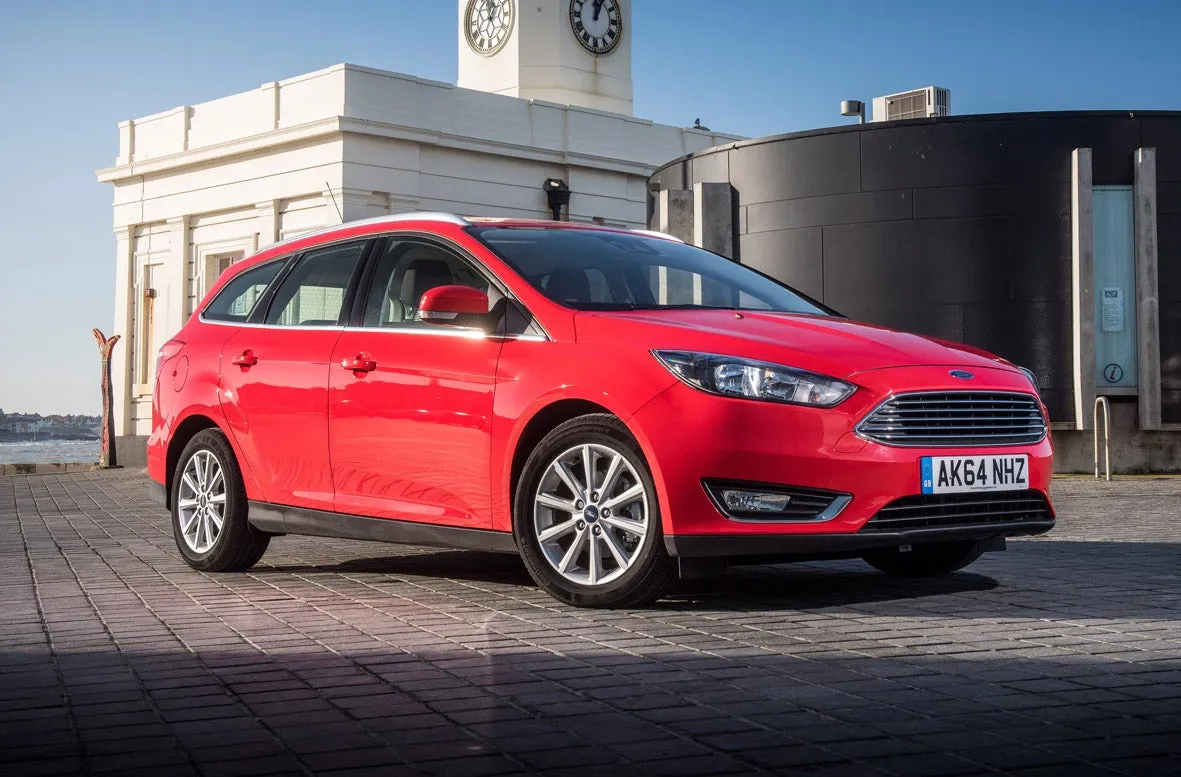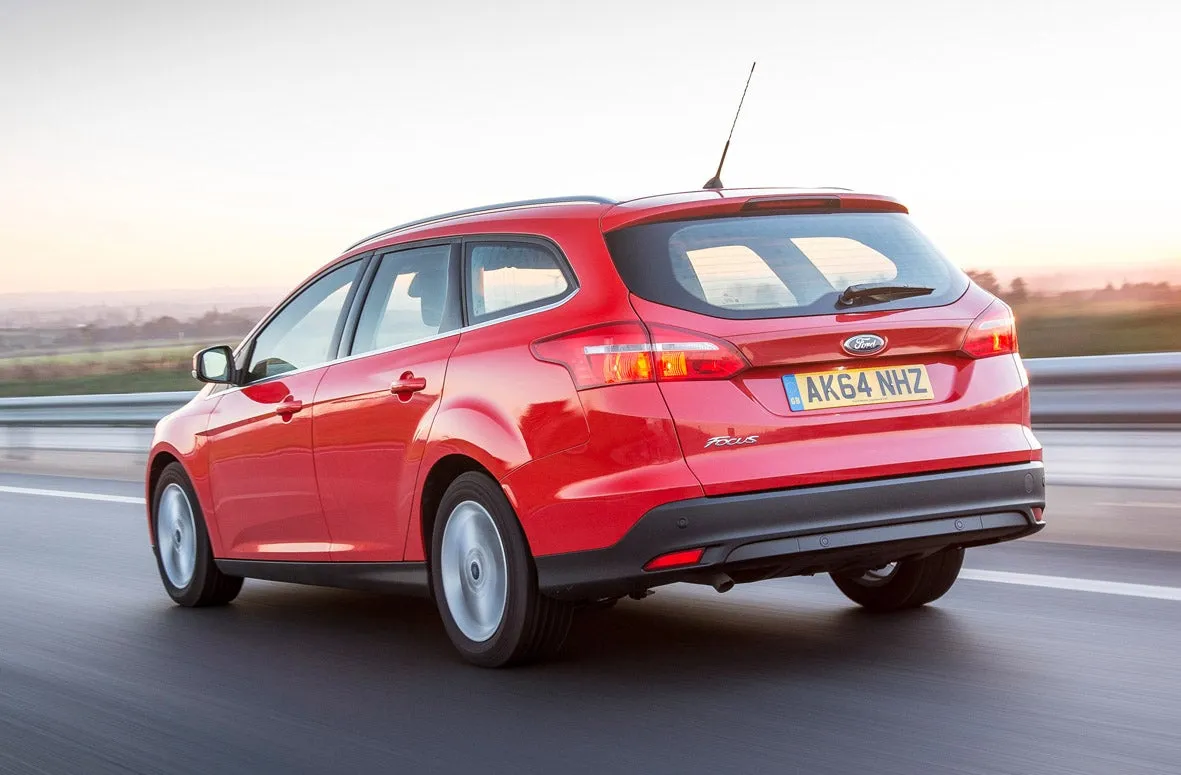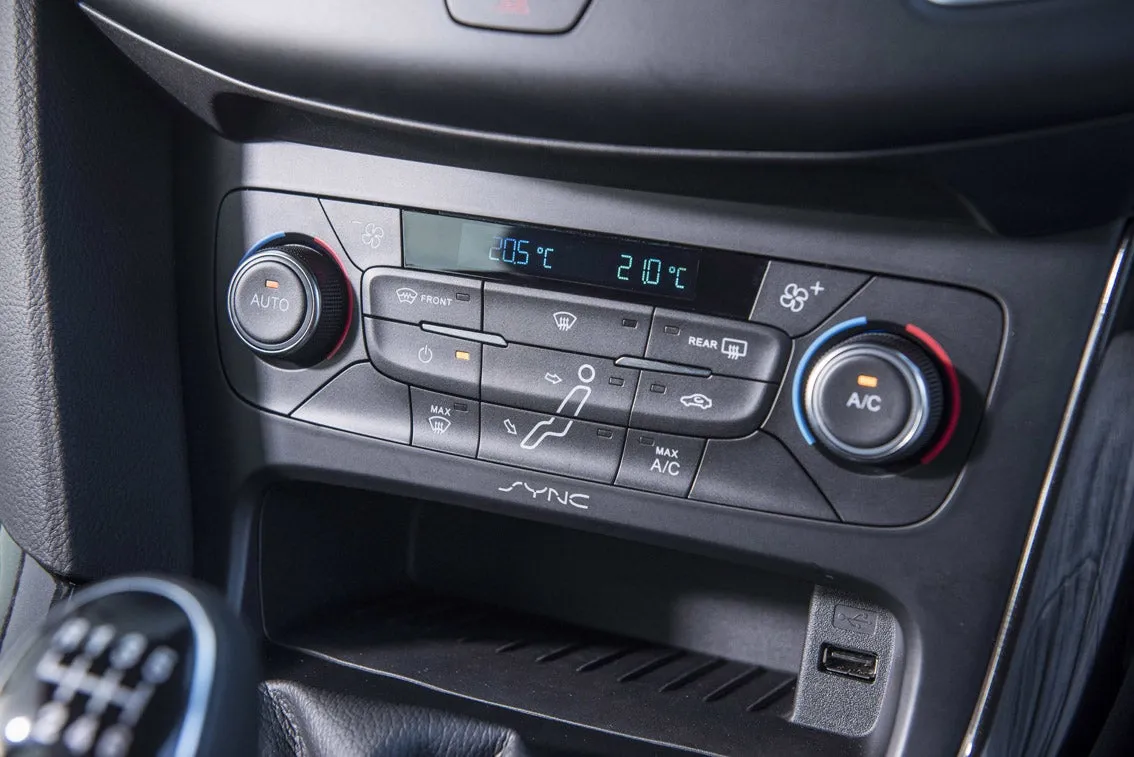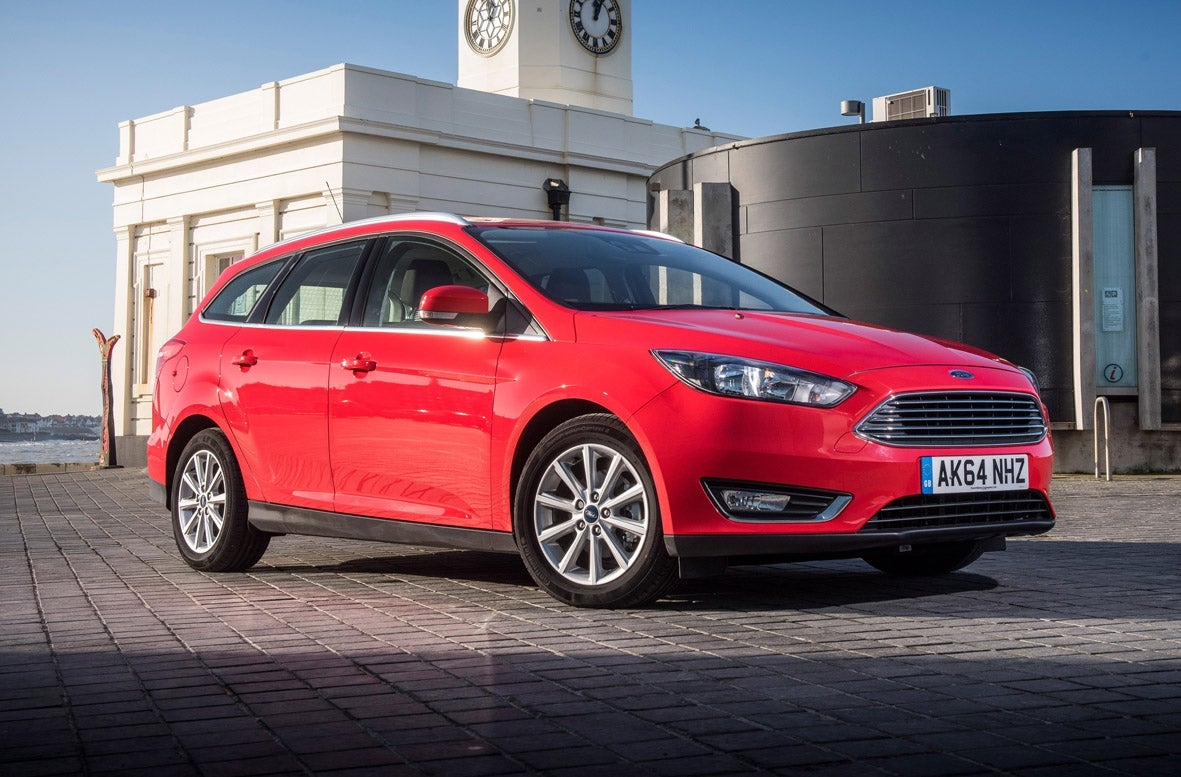Ford Focus Estate (2014-2018) Review
Written by Andrew Brady
Quick overview
Pros
- Strong engine range
- Excellent to drive
- Decent standard specification
Cons
- Not the biggest in the class
- Cabin feels penny-pinched in places
- Not what you’d call handsome
Overall verdict on the Ford Focus Estate
"In this Ford Focus Estate review we are looking at the load-carrying version of a hugely popular car. The Ford Focus hatchback has been a huge seller in the UK, but the estate version was much less popular. However, it still has the same strengths, being good to drive with a broad range of engines. It's not the biggest in the class and doesn't offer the nicest cabin either, but it's a solid choice."

The Ford Focus Estate arrived hot on the heels of the Focus hatchback, and unsurprisingly it shares many traits and features with that car. For starters, it’s unlikely you mistake the Ford Focus Estate for anything else - from the front it is indistinguishable from the hatchback with the prominent grille and large headlights.
The big changes only really come at the rear, where the estate tailgate is reasonably well integrated - it’s no looker of course, but you shouldn’t get mistaken for a window cleaner too often.
The Ford Focus Estate inherits almost the entire engine range from its hatchback brethren too, so there is a large mix of petrol and diesel engines with a range of performance and economy. Your cheapest option is the 1.6-litre petrol, but this relatively elderly motor is outclassed by the more modern turbocharged EcoBoost engines.
Available in 1.0-litre and 1.5-litre versions with two power outputs for both, they are efficient, pokey and pretty refined too. Big load haulers and long-distance drivers will want a diesel option, with three outputs on the 1.5-litre TDCi and a 2.0-litre TDCi for maximum performance.
Another thing that has translated well from the hatchback version is the way that the Ford Focus Estate drives. It is a compliment to say that from behind the wheel you’d be hard pressed to tell them apart without looking in your mirror.
The accurate and feel-some steering that is a hallmark of the hatchback is present here, and despite being designed as a load carrier, it handles with impressive competence. The ride quality is good on most surfaces yet the Ford Focus Estate will happily tackle a B-road, remaining composed and even entertaining should you be in the mood.
In practical terms the Ford Focus Estate is up there with the competition, although it cannot claim to be the best in the class. Compared to the regular hatch, the Focus Estate adds 160 litres of additional boot space, taking the total up to 476 litres with the rear seats in place and 1502 with them folded flat.
That will be more than enough for lots of buyers, but the Volkswagen Golf is considerably better with 605 litres and Skoda’s Octavia has a little more. Cabin space is similar to that of the Focus hatchback, so again competitive if not the best in class.
It’s not hard to see why the Ford Focus Estate is such a popular choice. It drives as well as the standard car, is spacious, practical and relatively good value. There’s little to criticise the Focus for in fact - it’s just that some of the competition is a little better in a few areas.
If you're looking for the newer version, you need our Ford Focus Estate (2022) review.
Is the Ford Focus Estate right for you?
There aren’t many situations where a car like the Ford Focus Estate can’t do a good job. As a family car it has all the right ingredients, with good space in the rear and a big load area that will swallow bulky buggies easily. There’s enough refinement and solid engine choices that it can carry out long-distance journeys on a regular basis, and it’s easy enough to drive that a daily commute is no sweat either.
Newer drivers may prefer the hatchback - it’s a little shorter and probably a little less intimidating to drive as a result - and unless you really need the space, it makes sense to go for the hatch too. There are more examples to choose from and you’ll find it easier to sell when the time comes too.
What’s the best Ford Focus Estate model/engine to choose?
What engine you choose depends on how you’ll spend most of your time behind the wheel. If it’s going to be doing a little of everything, including in and out of town or family duties, we’d suggest one of the EcoBoost offerings - either the 125PS 1.0-litre or either of the 1.5-litre versions. All provide useful performance with an eye on economy, and have low emissions too.
If you plan on loading up the boot regularly, particularly with heavy items, or you plan to tow a trailer or caravan, then a diesel is a must-have. The 1.5-litre TDCi in 120PS form can tackle most jobs, but the 2.0-litre TDCi with 150PS is able to cope with any load you can throw at it.
On the specification side of things, even the basic Style model has a decent amount of kit. Air con, hill start assist, electric front windows, DAB and Bluetooth are all standard so there’s no shame in going for the cheapest option. However, a short climb up to Zetec spec gets you the ever-useful heated windscreen as well as heated door mirrors, so makes a lot of sense.
What other cars are similar to the Ford Focus Estate?
You’re spoilt for choice really. Just as pretty much every car manufacturer has a compact hatchback designed to compete with the Focus, almost all of them also have an estate spin-off too.
There are rivals from the usual suspects, such as the Astra Sport Tourer, which is arguably better looking and almost as good to drive, while Volkswagen and its subsidiary brands have a competitor each. There’s the Volkswagen Golf Estate, affordable Skoda Octavia Estate, stylish SEAT Leon ST and even the Audi A4 Avant if you go premium, all of which offer varying combinations of space, value and poshness. Don’t forget cars like the Honda Civic Tourer and Toyota Auris Sports Tourer too.
Comfort and design: Ford Focus Estate interior
"Ford spend a lot of time ensuring their cars are suitable for a wide range of body shapes and sizes, so getting a decent driving position will be possible for almost everyone. Get into the driver’s seat and there’s seat height adjustment as standard, as well as rake and reach adjustment for the steering wheel. It’s easy for all passengers to get aboard too, with decent door apertures front and rear."

The layout of the cabin in the Ford Focus Estate is the same as in the hatchback, so it’s sensible and easy to understand, if a little unspectacular. There’s a large pair of instruments in the binnacle, with a small digital information screen that has quite a few functions and pages to flick through.
The centre of the dash has the infotainment screen perched on top with ventilation controls below that and ahead of the gearlever. Most of the buttons are quite small, and everything feels a little packed closely together. That’s partly because there are large high-level vents for the ventilation system also up on the dash, which is a good thing for those in the front row, but leaves the dashboard feeling a little busy.
Quality and finish
The Ford Focus Estate and its sibling models benefitted from an update in 2014 that improved the material finish in the cabin as well as tidying up the dashboard, and while this is definitely improvement on the previous version, it sits somewhere in the middle of the class rather than towards the top.
The important touch points are good quality and soft underneath your fingers; leather on the steering wheel helps here, but there’s also a lot of grey and black in the cabin and you don’t have to venture too far to find harder plastics that are less appealing.
This is at least partly countered by the fact that the standard of build quality appears to be quite high. Most of the fixtures and fittings click and snap with reassurance, although there has clearly been some efforts to save a little cost here and there. In day-to-day use you’re unlikely to find anything in here that isn’t up to the job and will likely stand the test of time, it’s just a shame that it isn’t more appealing to the senses in the process.
Infotainment: Touchscreen, USB, nav and stereo in the Ford Focus Estate
There are two different infotainment systems on the Ford Focus Estate depending on which trim level you go for. Even so, the basic provision is strong, with a radio/CD unit that includes DAB, AUX in and a USB input, plus Bluetooth for audio streaming and telephone operation. There’s steering wheel controls to operate some of these functions alongside the conventional buttons under the display screen.
Optional on higher spec models and standard on the Titanium and Titanium X models is the SYNC 2 touchscreen system, which incorporates voice control, sat nav, a search function when paired to a mobile phone and the option to input from more sources, including SD cards and even A/V in.
The basic system works well enough and offers a decent level of sound reproduction. The fact that it includes DAB and Bluetooth will actually be enough for a lot of buyers, although it’s not advanced enough to incorporate smartphone integration so it can’t be used as a sat nav in the conventional way. The SYNC 2 system is more versatile and works well, but is not essential unless you really have to have in-built sat nav.
Space and practicality: Ford Focus Estate boot space
A compact estate that isn’t spacious is not going to be very popular, but the Ford Focus Estate does a good job of making the most of the available footprint. If you’re sat in the front row you should have little trouble getting comfortable; there’s plenty of range of adjustment for both seats, with good legroom and headroom generous enough to accommodate those who are quite a bit over six feet tall. Shoulder room is good too, so you won’t be rubbing up against your passenger often.
In the rear it’s also good for the class, if not out in front. Legroom is good enough to accommodate adults up to six feet and possibly a little bit beyond, although you wouldn’t want to have two six-foot plus adults sitting in line with each other.
Two adults across the back is a breeze, and although you can squeeze a third in the middle, the seat isn’t shaped as comfortably and is pretty thin. You do at least get a proper three-point seat belt though, but the central transmission tunnel eats into legroom for the unlucky central passenger. For children in car seats the rear is plenty spacious, and for those old enough to do without, three across the rear shouldn’t be an issue.
Move out to the back, and the Ford Focus Estate continues to impress with the space available. The tailgate is large, well shaped and easy to open, while accessing the space is also helped by the fact that the loading lip is low and the boot floor is helpfully flat.
With 476 litres of space available most buyers will find the Ford Focus Estate is amply spacious unless you will regularly pack your estate to the roof. It also has some useful features that estate buyers will find useful, such as lashing eyes to keep your stuff tied down and a 12V power socket in the rear too. Fold the rear seats and you have access to 1502 litres.
There’s also useful space in the cabin, with decent door bins and a couple of cubbies along the centre console, but it can’t quite match the practicality of the Skoda Octavia in this respect.
The Ford Focus Estate dimensions are 4556mm long, 2010mm wide and 1492mm tall.
Handling and ride quality: What is the Ford Focus Estate like to drive?
"Ford, and the Ford Focus Estate in particular, has a well-deserved reputation for offering impressive handling alongside good ride quality, and that this isn’t just reserved for the sporty models at the top of the range is a real positive. It is true to say that this generation of Ford Focus Estate isn’t quite the paragon of driving excellence that its predecessors were, but it still sets a high standard for the class."

The steering is a strong point, and while some of the delightful feedback that made the Ford Focus Estate so good to drive has been lost, it still provides a positive response to inputs from the driver and good weighting. Whether you’re just negotiating your way through a traffic jam or having some fun on a B-road, the steering helps you feel keyed-in to the car and what it’s doing as well as the road surface, which inspires confidence in the driver.
The suspension is also very good, in that it strikes an excellent balance between ride comfort and handling prowess. Ford made a big noise about fitting the first Ford Focus Estate with independent rear suspension - more costly, but providing better performance - and such was the effect that many of its rivals switched to a similar system.
The Focus still has a version of this system on the Ford Focus Estate, and it gives it the ability to change direction and react to the driver’s inputs in a way you might not expect from a humble compact estate. If you choose to drive with vigour it is a lot of fun, but if you just want to get from A to B you’ll find the suspension deals with road imperfections comfortably, and rarely gets caught out by poor surfaces.
What engines and gearboxes are available in the Ford Focus Estate?
With so much engine choice there should be a powerplant for all needs, but there also a few options that are best avoided. The cheapest models on the market will likely be fitted with the 1.6-litre petrol engine, and while it is cheap, it’s also quite old-tech and offers unspectacular performance and economy.
If you want a petrol engine it really has to be one of the EcoBoost units. Of the 1.0-litre versions, the 100PS model has just enough grunt to keep you in the swim, but for general use the 125PS version is better. If you plan to regularly load up the boot with stuff, the 1.5-litre options are more capable, can deal with higher speeds on the motorway comfortably and still offer decent fuel consumption too.
As for the diesel options, the 1.5-litre comes in three power outputs, one of which should satisfy all but the most serious of load carriers.
The mid-level 105PS version is also available in Econetic trim, and so equipped can deliver some impressive fuel consumption figures while still having enough torque to make decent progress. The 120PS version is the pick of the 1.5-litre diesels however, and hits the sweet spot of pulling power, low fuel consumption and emissions.
If you intend to use the Ford Focus Estate as God intended and cart about huge, heavy loads and make use of a tow bar on a regular basis, then the 2.0-litre TDCi unit with 185PS is capable of dealing with all of it. Although it can’t match the frugality of the smaller diesel offerings.
Refinement and noise levels
No one expects a car like the Ford Focus Estate to provide church-like silence, but at the same time unwelcome noise levels can make a car a wearing experience for anyone travelling in them. The Ford Focus Estate is competitive in this respect, but not the best in class.
On the whole the engine range is quite refined, although the 1.6-litre petrol can be a little gruff, and the smaller 1.0-litre EcoBoost units do get a little louder when extended. Yet for the most part, in normal driving, engine noise levels are kept in check, so longer distance journeys can be completed in relative comfort.
Other noise sources are generally kept to a low level too, although the Ford Focus Estate does start to suffer a little at higher motorway speeds.
Tyre noise is relatively hushed and on a par with rivals - Econetic models and those versions wearing bigger wheels and tyres do have a little more road noise, but not so much that it becomes an issue. Wind noise is a little more prevalent at higher speeds though, something which is less apparent on cars like the Volkswagen Golf and Honda Civic.
Safety equipment: How safe is the Ford Focus Estate?
Euro NCAP tested the Ford Focus Esate in 2012 when this generation model was first launched, and although the model tested was the hatchback, the same results apply to the estate version.
The Ford Focus Estate was awarded an impressive five star overall rating by EuroNCAP, with the 92% for adult protection being a particularly high score. Child protection was given an 82% score, with pedestrian mitigation at 72% and safety assist at 71%, a strong performance in all categories.
As standard, the Ford Focus Estate is fitted with six airbags, including full-length curtain airbags and side airbags for the front seat passengers, seat belt pre-tensioners and load limiters, ISOFIX child seat mounting points in the rear and electronic aids such as ESC and hill start assist.
Available as an option on lesser models but standard on Titanium and Titanium X models is Active City Stop, Ford’s name for autonomous emergency braking, which is a big boost for active safety.
Further optional extras include traffic sign recognition and enhanced parking systems, including an automated system that is able to park the car automatically in parallel or bay parking spaces, in addition to parking sensors that are standard on Titanium and Titanium X models. It is important to check the specification of a prospective car carefully to see if these systems are fitted or not, as they are worth having if your budget can stretch to it.
MPG and fuel costs: What does a Ford Focus Estate cost to run?
"Thanks to a range of (mostly) modern engines the Ford Focus Estate is capable of impressive fuel consumption - although it is worth noting that the quoted figures are based on the old and more generous NEDC system."

The 1.0-litre EcoBoost petrols claim 58mpg and 51mpg respectively for the 105PS and 125PS versions, so as long as you’re sensible with the accelerator you should be able to get 40mpg on a regular basis. Even the bigger 1.5-litre EcoBoost claims up to 50mpg for the 150PS version, so you can have the performance and still creep into 40mpg territory.
It’s the diesels that steal the headlines though, with the most frugal 1.5-litre TDCi Econetic claiming a remarkable 83mpg combined. You’ll do well to hit that on a regular basis, but you can expect 60mpg and more with relative ease, even 70mpg if you try hard.
How reliable is a Ford Focus Estate?
The Ford Focus scored a disappointing 8.95 out of 10 for reliability in the HonestJohn.co.uk Satisfaction Survey, which is lower than several key rivals. Historically there have been issues with a coolant pipe on EcoBoost engines which should have been rectified under recall, so check your car has had this work carried out.
As a brand Ford finished a disappointing 26th out of 30 manufacturers overall.
Insurance and group costs
It might be a mid-sized car with the option of relatively powerful engines, but a combination of low repair costs and good security systems contribute to the Ford Focus Estate featuring relatively low down on the insurance group ratings. Remarkably, the 1.6-litre petrol drops into group 6 - lower than some city cars, although this is not the engine of choice.
The 1.0-litre EcoBoost petrols are around group 11 and the 1.5-litre diesels only climb as high as group 16, and even the top 2.0-litre diesel squeezes under group 20, although higher spec versions do creep into higher groups.
VED car tax: What is the annual road tax on a Ford Focus Estate?
Like most cars that cover the period in April 2017 when the VED rules changed significantly, the Ford Focus Estate can cost you nothing, or considerably more, depending on how old the car is but also what engine you go for. Early EcoBoost 1.0-litre petrols and the smaller diesels qualify for £20 per year VED under the pre-April 2017 rules, but jump up to £165 afterwards. ECOnetic models dip under the 100g/km barrier and so are VED free pre-April 2017 but are also £165 afterwards.
How much should you be paying for a used Ford Focus Estate?
"You won’t have to look very far to find a Focus for sale, even in estate form, which means plenty of choice for the buyer."

The earliest examples are now well into bargain territory. The earliest example we found from 2015 had 77,000 miles on the clock in 1.0 EcoBoost Zetec trim, and was a modest £6,500. A little more money would get you a smart TDCi model in high-spec Titanium trim for just over £7,500 too.
Trim levels and standard equipment
Ford Focus Estate Style models come with roof rails, air conditioning, Easy-Fuel misfuelling prevention, hill start assist, electric front windows, 16-inch steel wheels, DAB radio, AUX in, USB in and Bluetooth connectivity.
Ford Focus Estate Zetec trim adds 16-inch alloy wheels, Quickclear windscreen, heated door mirrors and front fog lights. Ford Focus Estate Zetec S trim adds 17-inch alloy wheels, styling kit, sports pedals, sports suspension, keyless start, LED running and rear lights.
Ford Focus Estate Titanium trim comes with 16-inch alloy wheels, SYNC2 touchscreen, active city stop, auto lights, auto wipers, an auto-dimming rear view mirror, rear parking sensors, dual-zone climate control plus cruise control with speed limiter.
Ford Focus Estate Titanium X adds 17-inch alloy wheels, enhanced park assist, with front and rear parking sensors, a rearview camera, xenon headlights, part-leather seats, heated front seats, power-operated driver’s seat along with LED ambient lighting.
In 2016 Ford added the ST-Line model, which added a honeycomb front grille, fog lamps with dark surrounds, a rear diffuser element, rear roof spoiler, side-skirts, ST-Line exterior badging, unique 17-inch in alloy wheels, sport seats, perforated leather ST-style steering wheel, ST-style gear knob, a dark woven headliner and ST-Line scuff plates.
Ask the heycar experts: common questions
Are Ford Focus Estates reliable?
Is the Ford Focus an Estate?
Why is the Ford Focus being discontinued?
Get our latest advice, news and offers
Keep me updated by email with the latest advice, news and offers from heycar.
By submitting you agree to our privacy policy



